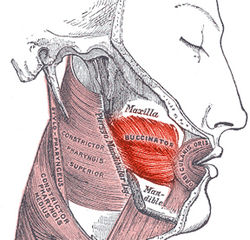Buccinator
| Buccinator muscle | |
|---|---|

Buccinator outlined in red.
|
|
| Details | |
| Origin | from the alveolar processes of the maxillary bone and mandible, temporomandibular joint |
| Insertion | in the fibers of the orbicularis oris |
| Artery | buccal artery |
| Nerve | buccal branch of the facial nerve (VII cranial nerve) |
| Actions | The buccinator compresses the cheeks against the teeth and is used in acts such as blowing. It is an assistant muscle of mastication (chewing) and in neonates it is used to suckle. |
| Identifiers | |
| Latin | Musculus buccinator |
| TA | A04.1.03.036 |
| FMA | 46834 |
|
Anatomical terms of muscle
[]
|
|
The buccinator (/ˈbʌksɪneɪtər/ ) is a thin quadrilateral muscle, occupying the interval between the maxilla and the mandible at the side of the face. It forms the anterior part of the cheek or the lateral wall of the oral cavity.
It arises from the outer surfaces of the alveolar processes of the maxilla and mandible, corresponding to the three pairs of molar teeth; and behind, from the anterior border of the pterygomandibular raphé which separates it from the constrictor pharyngis superior.
Origin: pterygomandibular raphe and surrounding bony structures. Insertion: modiolus.
The fibers converge toward the angle of the mouth, where the central fibers intersect each other, those from below being continuous with the upper segment of the orbicularis oris, and those from above with the lower segment; the upper and lower fibers are continued forward into the corresponding lip without decussation.
Motor innervation is from the buccal branch of the facial nerve (cranial nerve VII). Sensory innervation is supplied by the buccal branch (one of the muscular branches) of the mandibular part of the trigeminal (cranial nerve V).
Its purpose is to pull back the angle of the mouth and to flatten the cheek area, which aids in holding the cheek to the teeth during chewing. This action causes the muscle to keep food pushed back on the occlusal surface of the posterior teeth, as when a person chews. By keeping the food in the correct position when chewing, the buccinator assists the muscles of mastication.
...
Wikipedia
